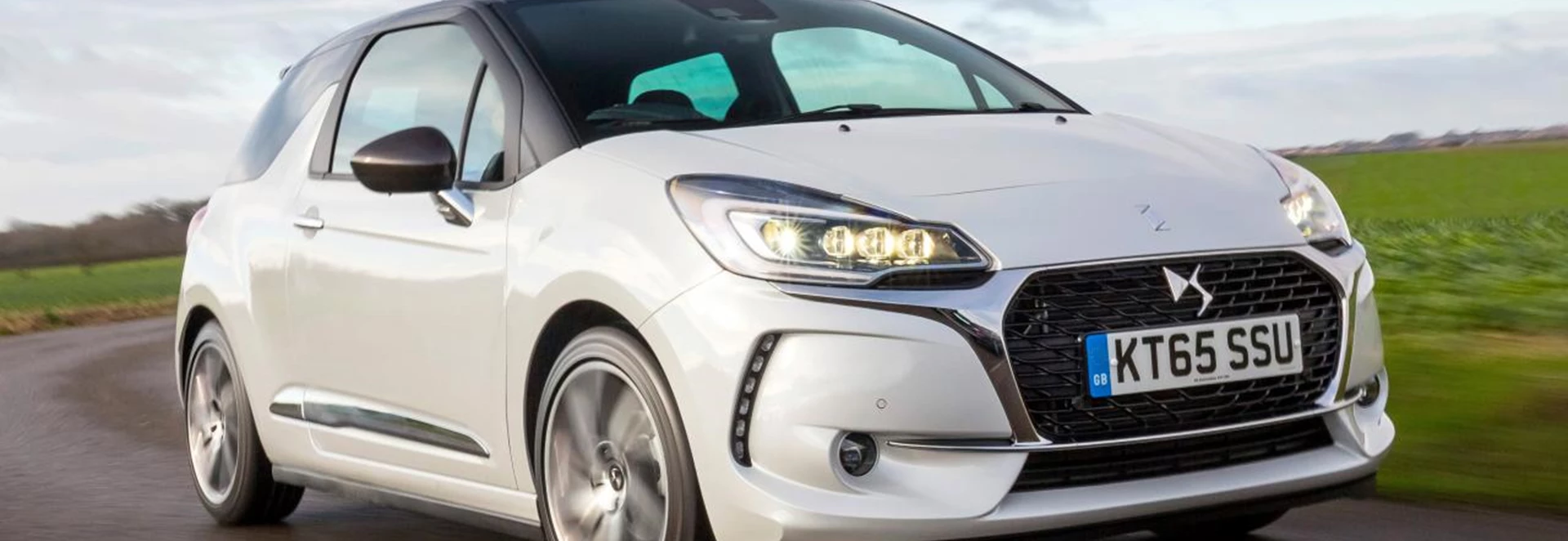Introduction
The DS brand decided to expand the appeal of its hatchback in 2013 by introducing the open-topped Cabrio version. Despite its name, it's not a full-scale convertible but a hatchback with a fabric roof which opens and closes by moving along side channels. Even with the roof fully down it feels more like a hatchback with an enormous sunroof than a proper cabriolet, though the system does mean that moving it from one position to another is possible at speeds of up to 75mph.
Just like its hatchback sibling, the DS 3 Cabrio has recently undergone a liberation from the Citroen brand as the DS name is now a standalone carmaker. With that comes a new DS Wings front-end – due to the obvious removal of Citroen badging – and a revamped interior design.
The range follows that of the DS 3 hatch very closely though. Most of the engines run on petrol and have either three or four cylinders – but there are also some frugal diesels to boot. The talking point of the engine range however is the addition of the new three-cylinder PureTech 130 petrol, which has already impressed punters in the new Peugeot 208.
Performance
There is no shortage of choice here. The 81bhp 1.2-litre three-cylinder PureTech engine takes 14.4 seconds to push the DS 3 Cabrio from zero to 62mph, and that might be enough if you're only ever going to make short journeys or are more interested in style than speed. If you do want a bit of grunt then you can go for the THP 165 petrol unit, which does the same sprint in 7.5 seconds.
If you ask us though, the pick of the range by a country mile is the new 1.2-litre PureTech 130 turbo, which delivers more poke then you may think with a zero to 62mph sprint time of just nine seconds. This is only available with a six-speed manual gearbox, which is snappy enough to have fun – albeit suffering from an ever so slightly long throw.
Both diesel offerings in the range are impressive, with either 99bhp or 118bhp outputs available. The 118bhp is your best bet though for power and efficiency.
Ride and Handling
Anyone who enjoys the driving characteristics of the DS 3 hatchback might take some persuading to switch to the Cabrio. Removing the roof reduces body stiffness and has a noticeable effect - there's some body shake on rougher surfaces, and the THP 165 in particular can sometimes struggle under power in mid-corner, though not to the same extent as the unruly Cabrio Racing did.
The three-cylinder models may be less powerful than their four-cylinder counterparts, but their lighter engines mean there's a better weight balance and less for the front tyres to do, so they can be good fun to drive if not especially quick.
The three-cylinder models may be less powerful than their four-cylinder counterparts, but their lighter engines mean there's a better weight balance.
Did you know?
The Cabrio made its first public appearance at the 2012 Paris Show, two and a half years after the hatchback went on sale.
Interior and Equipment
The interior design is identical to that of the hatchback, but luggage space inevitably suffers, with a 40-litre reduction in capacity to 245 litres, vastly more than you get in the convertible versions of the MINI and the Fiat 500C. The boot lid is interesting (a thing not often said) because it opens up rather than out, so you can load up even when there isn't much room behind the car. It's also quite narrow though, so access can be tricky.
The roof can be opened to varying degrees, one of them clearing the heads of just the front passengers and another giving infinite headroom to all four. In its most open position, known as "total", it takes up all the space previously given over to the now disappeared rear window, reducing rear visibility to as near zero as makes no difference.
As part of its recent update, the Cabrio’s trim levels have been reworked. Excluding special edition models, the trims now consist of Chic, Elegance and Prestige. Those after something a bit special can go for Ultra Prestige, Performance and Performance Black. The key difference appearance wise in the cabin is the reduction in buttons on the dash – 20 less in fact.
All models come well-equipped with DAB digital radio, rear parking sensors, Bluetooth, air-con, cruise control and, a new safety addition, Active City Brake.
Cost
Cabrios are about £4,000 more expensive than DS 3 hatchbacks (the exact figure depends on which model you're talking about) and are priced similarly to MINI Convertibles and considerably higher than the Fiat 500C.
Running costs should be similar to those of the hatch, with CO2 emissions and fuel economy ranging from 92g/km and around 80mpg to 129g/km and 50.4mpg. The new PureTech 130 emits as low as 105g/km.
The new PureTech 130 emits as low as 105g/km.
Our Verdict
Keen drivers will prefer the dynamics of the structurally stiffer hatchback, but the DS 3 Cabrio scores a lot of points for being a surprisingly practical convertible version of an already attractive little car.
Some people may, however, be disappointed that it always looks like a hatchback from the side (as, in fairness, the Fiat 500C does) regardless of what you do with the roof.
The new changes have made a difference though – the interior is slightly less cluttered, the front-end looks better than ever and the new PureTech 130 three-cylinder petrol is on the money.




